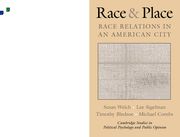Book contents
- Frontmatter
- Contents
- List of Figures
- List of Tables
- Preface
- 1 Introduction
- 2 Race Relations in Detroit, 1968–1992
- 3 Black–White Social Interaction
- 4 Perceptions of Racial Discrimination
- 5 Black Racial Solidarity
- 6 White Racial Prejudice
- 7 Opinions on Urban Issues: The Schools and the Police
- 8 Conclusions
- Appendix A The Detroit Surveys
- Appendix B Detroit Survey Items and Measures
- References
- Author Index
- Subject Index
- Miscellaneous Endmatter
3 - Black–White Social Interaction
Published online by Cambridge University Press: 05 June 2012
- Frontmatter
- Contents
- List of Figures
- List of Tables
- Preface
- 1 Introduction
- 2 Race Relations in Detroit, 1968–1992
- 3 Black–White Social Interaction
- 4 Perceptions of Racial Discrimination
- 5 Black Racial Solidarity
- 6 White Racial Prejudice
- 7 Opinions on Urban Issues: The Schools and the Police
- 8 Conclusions
- Appendix A The Detroit Surveys
- Appendix B Detroit Survey Items and Measures
- References
- Author Index
- Subject Index
- Miscellaneous Endmatter
Summary
Black and white America have been described as two separate, hostile, and unequal nations (Hacker, 1992). The appropriateness of the latter two adjectives has been documented in study after study of racial attitudes and of the legal, economic, and social status of African Americans, but far less attention has been paid to racial separateness and its consequences.
Several unanswered but fundamental questions about interracial contact are central to our study. Context can be crucial in reshaping blacks' and whites' attitudes toward each other in more positive directions only if in interracial neighborhoods blacks and whites actually have contact with one another. Thus, we believe that context affects attitudes through informal interactions and friendships and by shaping the composition of political, sports, religious, social, and other neighborhood organizations that provide opportunities for interactions involving a range of people (Huckfeldt, 1986). So neighborhood context is not just a “black box” into which people enter who happen to live in houses in some proximity to those of another race and from which they emerge with changed attitudes. What happens inside the box – how and how frequently people come into contact with each other – is the key to attitude change. Sheer proximity of the races to one another (Alba and Logan, 1993) will matter little without this intervening step.
In this chapter we ask whether mixed residential neighborhoods promote interracial contact, ranging from casual encounters to intense personal relationships.
- Type
- Chapter
- Information
- Race and PlaceRace Relations in an American City, pp. 47 - 70Publisher: Cambridge University PressPrint publication year: 2001



